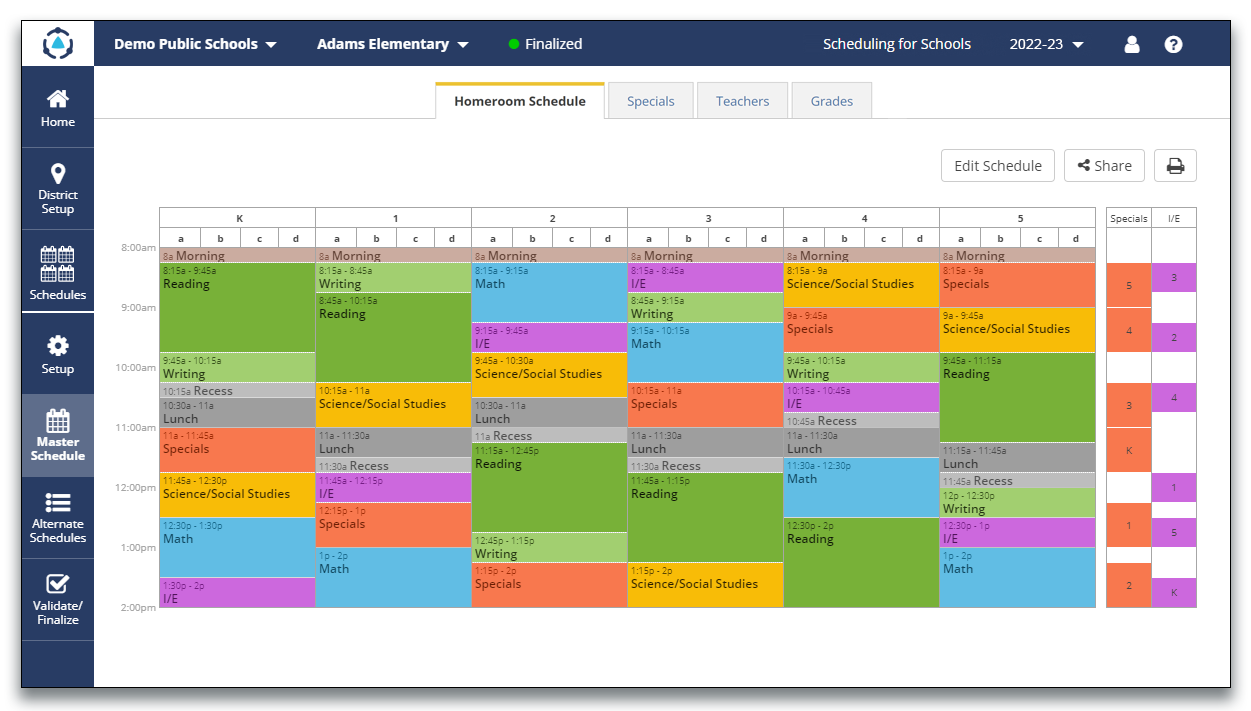
Building an Elementary Schedule - Part 5: Lunch and Recess Scheduling
This 12-part series on How to Build an Elementary School Schedule offers step-by-step guidance and proven scheduling strategies for creating a better elementary school schedule.
Scheduling lunch and recess are the next steps in making an elementary school schedule after scheduling specials. As you may already know, lunch and recess scheduling can be more complicated than it may seem on the surface. A number of factors must be taken into account, including timing, lunchroom capacities, avoidance of long lunch lines, duration, transitions, and recess/playground capacity. Before you schedule lunch and recess, consider these questions.
How long should lunch last?
Due to USDA guidelines (See 2023 proposed updates here) not specifying an amount of time for lunch, it is up to districts and schools to decide how much time to devote to lunch while keeping curriculum requirements in mind. The School Nutrition Association's State of School Nutrition 2018 survey, which included responses from 1,550 schools nationwide, reported the typical lunch period length is about half an hour, with a median of 25 minutes reported for elementary schools.
The averages are aligned with research that indicates students need at least 20 minutes in their seats to eat. This excludes waiting time in line, using the bathroom, or other transition activities. When thinking about how much time your students need, consider starting at 20 minutes and adding time for transition activities (e.g. 20 minutes eating time + 2 minutes walk to cafeteria + 3 minutes waiting in lunch line = 25-minute lunch period.
Adequate time ensures students get the nutrition they need to grow and learn while wasting less food. Considering how lunch lines will affect seat time if your school has a large number of free and reduced lunch students. For many students in poverty, school breakfast and lunch are their only or most nutritious meals.
Is it better to schedule lunch and recess back-to-back or schedule them separately at different parts of the day?
There is no right or wrong answer here. The right decision for your building should take into account your students, climate, and other factors that vary from school to school and region to region. It is also important to consider the physical space available for lunch and recess.
Research has shown, however, that scheduling lunch and recess in sequence provides some benefits; students who take recess before lunch eat more and healthier food than students who take it after lunch. Having recess first helps students build up their appetites and reduces the likelihood of students rushing through lunch to get to recess while reducing platewaste.
Consider experimenting with alternate lunch and recess waves in some grades if you can't make this happen for all grades each year.
What is the best time for recess? Before lunch or after lunch?
There is no right or wrong answer here. The right decision for your building should take into account your students, climate, and other factors that vary from school to school and region to region. It is also important to consider the physical space available for lunch and recess.
Research has shown, however, that scheduling lunch and recess in sequence provides some benefits; students who take recess before lunch eat more and healthier food than students who take it after lunch. Having recess first helps students build up their appetites and reduces the likelihood of students rushing through lunch to get to recess while reducing platewaste.
Consider experimenting with alternate lunch and recess waves in some grades if you can't make this happen for all grades each year.
Which grades should be combined and how many waves are needed?
Every school must work within its own cafeteria's capacity constraints when scheduling lunch waves. Begin by defining the cafeteria's student capacity, and then determine how many classrooms can safely fit in there at once.
Identify your lunch window constraints next. When can lunch start? Does your cafeteria share a space with other classes (such as PE and music)? In order to prepare a multipurpose room for lunch or clean up after lunch, how much time is required?
When students have transitioned from lunch waves to the cafeteria, how long does it take for them to get through lunch lines while other students are leaving the lunchroom? To reduce lunch line wait times, consider staggered start times for grades or sections.
Finally, consider any guidelines your school or district has about which grades can have lunch or recess together. While some schools prefer combining the oldest and youngest grades (e.g. 1 and 5), others schedule adjacent grades (4 and 5) to manage discipline issues.
Contracts with food service providers may dictate some of the above considerations. Make sure that you consider your goals and constraints to find what works best for your students in the constraints of your schedule.
Need Support with Scheduling?
DMSchedules Can Help.
The key to scheduling success is preparation and planning. Start taking action now so that you and your scheduling team are well-positioned for success this scheduling season. If you need help building your elementary school schedule, reach out to us. We can take scheduling off your plate, and create your school schedule aligned with your learning goals.

